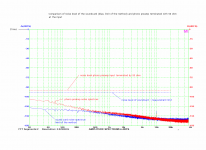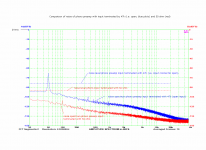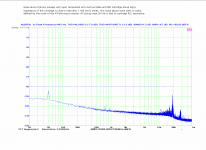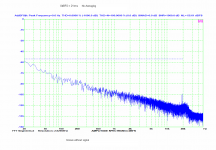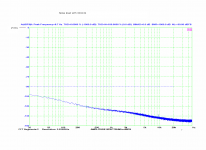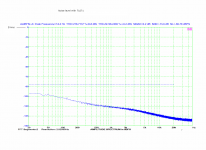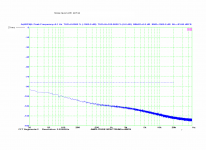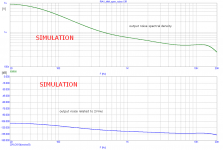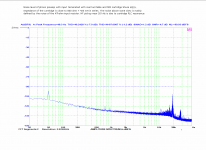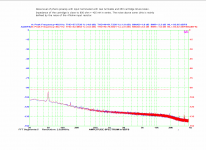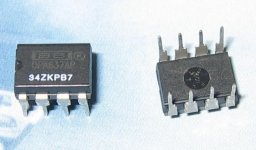I have all the measurements you speak about, I can post them tomorrow. I also have measurements with vinyl groove etc. The preamp is really quiet enough and when properly wired it is absolutely hum free. The measurement with cartridge has 0dB ref 2Vrms. Dashed line is noise level over 20Hz - 20kHz ref 2Vrms output.
It might be nice to post spectra with the cartridge compared to shorted input- that way, you demonstrate that the preamp is not the limitation (assuming that's not the case!).
OK, I have prepared several comparison measurement. They are measured by a system that is created by SB X-Fi HD USB sound card and Virtins technology Multi-Instrument 3.2 software. This SW is able to calculate properly SNR and noise level over defined frequency range. The noise level is measured over 20Hz - 20kHz frequency range, unweighted, and can be seen as dashed lines in attached images. The noise level is related to 0dBFS, which is 2Vrms in all these measurements.
1st image is a noise plot of the sound card (measurement limit) vs. noise of the phono preamp terminated with 47k at the input, i.e. in fact the input connector of the preamp is left open.
2nd image is a noise plot of the preamp with input terminated with 47k (open input) vs. input terminated with 50 ohm.
3rd image is a noise plot of the preamp with real turnatable and cartridge Shure M35X connected to the input.
The results are:
- noise level limit of the method is -99 dBFs
- noise level of the preamp terminated with 50 ohm at the input is -96 dBFS
- noise level of the preamp with input connected to the real turntable cartridge is -90 dBFS
- noise level of the preamp with 47k at the input (open input) is -84 dBFS
Attachments
But, the main contributor of the noise is NOT the preamplifier, but the vinyl groove itself. I have a plenty of measurements of noises of plain vinyl surface, "empty" ("silent") grooves, grooves "without signal" from measuring records etc. The real record would worsen the noise about 30 dB compared to the measurement of the preamp connected to the cartridge with needle "in the air". Please see one of the measurements of the vinyl groove "without signal". Especially the low frequency noise of the vinyl is quite horrible.
Attachments
As we can read in the manual, the recommended opamp for this preamplifier is OPA627 (bought at reliable supplier like Farnell, please avoid cheap offers, fakes for sure).
Let's see what happens with noise level when we replace the OPA627 with OPA134, TL071 and AD744. But, how much important is this considering the vinyl groove noise? It is up to the builder, but I still recommend the OPA627. For those who would like to use something cheaper I would admit to use the OPA134, but nothing worse. All these measurements with input teminated with 50 ohm.
Let's see what happens with noise level when we replace the OPA627 with OPA134, TL071 and AD744. But, how much important is this considering the vinyl groove noise? It is up to the builder, but I still recommend the OPA627. For those who would like to use something cheaper I would admit to use the OPA134, but nothing worse. All these measurements with input teminated with 50 ohm.
Attachments
I have also simulated the noise of the phono preamp with cartridge impedance (R + jwL) at the input. The concordance with measurements of the noise of the preamp with cartridge is stunning.
Attachments
Hello Pavel,
Mouser, for example, got various types of OPA627 in stock.
Could you give some hints witch one to pick ?
627
Normally, OPA627AP/BP and APG4/BPG4 should be OK. Let's hope they are genuine. I have built my preamps from the old stock of Burr-Brown OPA627AP genuine components, but unfortunately I have no more pieces.
I hope not. But I am not 100% sure, I recall something like a warning of one of my colleagues regarding this part. But I am really not sure and do not want to start any panic. This should be the list of TI official distributors in Germany
Semiconductor Distributors: Germany - TI.com
and Mouser is in the official list, so it should be OK. You might also try to ask at your German analog-forum.de, maybe Holger or someone would know?
Semiconductor Distributors: Germany - TI.com
and Mouser is in the official list, so it should be OK. You might also try to ask at your German analog-forum.de, maybe Holger or someone would know?
3rd image is a noise plot of the preamp with real turnatable and cartridge Shure M35X connected to the input.
The results are:
.
.
.
- noise level of the preamp with input connected to the real turntable cartridge is -90 dBFS
I have a new measurement of the noise level of the preamp connected to the turntable and cartridge. The previous one was done on the prototype placed in a provisional case. The new measurement is made with preamp and PSU in a final case 19" 1U, one can see improvement in the noise level a HF resonance pickup.
Attachments
Hi mlloyd,
something similar is done by R2 + C2 (at the input). This prevents the gain plot from remaining at 0dB at high frequencies. I want to maintain "strong" output, and the circuit works well even into 50 ohm or 32 ohm. 2nd reason not to add resistance is to keep 51 ohm output impedance (and thus low influence of interference in case one uses the 50 ohm coax.).
Anyway, it is the cartridge inductance that dominates in overall HF behavior.
something similar is done by R2 + C2 (at the input). This prevents the gain plot from remaining at 0dB at high frequencies. I want to maintain "strong" output, and the circuit works well even into 50 ohm or 32 ohm. 2nd reason not to add resistance is to keep 51 ohm output impedance (and thus low influence of interference in case one uses the 50 ohm coax.).
Anyway, it is the cartridge inductance that dominates in overall HF behavior.
Last edited:
Wow! Great project PMA, thanks so much!
Well thought out, well engineered, good design cycle, exact testing, thorough documentation ... even nice pictures!

Oh yeah, and kick-*** performance!
I absolutely LOVE the idea of plugging headphones straight into this! It seems so obvious in hindsight --- beefier output to drive lower-noise feedback and enough output for ... headphones! Brilliant!
It doesn't get any more direct than that! Forget cables, forget preamps, forget extra amplification/current stages ... s i m p l i c i t y !
Now, I've got to find that headphone extension cord for my shorter headphones ...
PMA:
"Normally, OPA627AP/BP and APG4/BPG4 should be OK. Let's hope they are genuine. I have built my preamps from the old stock of Burr-Brown OPA627AP genuine components, but unfortunately I have no more pieces. "
Could you say more about these different grades and production runs of 627? How do we tell them apart? (Or should this be another thread?)
Here's my old ones:
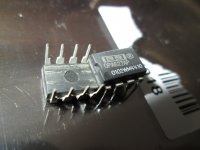
Cheers,
Jeff
Well thought out, well engineered, good design cycle, exact testing, thorough documentation ... even nice pictures!

Oh yeah, and kick-*** performance!
I absolutely LOVE the idea of plugging headphones straight into this! It seems so obvious in hindsight --- beefier output to drive lower-noise feedback and enough output for ... headphones! Brilliant!
It doesn't get any more direct than that! Forget cables, forget preamps, forget extra amplification/current stages ... s i m p l i c i t y !
Now, I've got to find that headphone extension cord for my shorter headphones ...
PMA:
"Normally, OPA627AP/BP and APG4/BPG4 should be OK. Let's hope they are genuine. I have built my preamps from the old stock of Burr-Brown OPA627AP genuine components, but unfortunately I have no more pieces. "
Could you say more about these different grades and production runs of 627? How do we tell them apart? (Or should this be another thread?)
Here's my old ones:

Cheers,
Jeff
Last edited:
Hi Pavel:
I am having a little trouble with the BOM. You list part numbers for Farnell and something called GME. I am not familiar with the latter and have been unable to locate them. I am familiar with capacitor types FKP2 and and X7R, but what does CF3 mean? Under the columns "Library" I assume something like "C-5" means 5mm lead spacing, is that correct? Are the CF3 caps just polyesters of the appropriate lead spacing? I assume 50V or better is sufficient for all the capacitors? Resostors: all 1% metal film, 1/4Watt OK?
Thanks.
I am having a little trouble with the BOM. You list part numbers for Farnell and something called GME. I am not familiar with the latter and have been unable to locate them. I am familiar with capacitor types FKP2 and and X7R, but what does CF3 mean? Under the columns "Library" I assume something like "C-5" means 5mm lead spacing, is that correct? Are the CF3 caps just polyesters of the appropriate lead spacing? I assume 50V or better is sufficient for all the capacitors? Resostors: all 1% metal film, 1/4Watt OK?
Thanks.
.. Under the columns "Library" I assume something like "C-5" means 5mm lead spacing, is that correct? ...
Nice! 2.5, 5, 5.5, 7.5mm!
...Are the CF3 caps just polyesters of the appropriate lead spacing? I assume 50V or better is sufficient for all the capacitors?
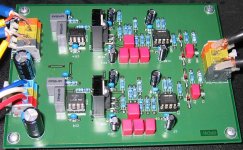

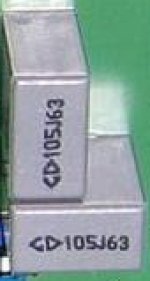
105J63
Cornell Dubilier, Film Capacitors, Polyester , 1 uF, 5 %, 63 V, 7.5mm
167105J63C-F Cornell Dubilier | Mouser
Last edited:
Hi Pavel:
I am having a little trouble with the BOM. You list part numbers for Farnell and something called GME. I am not familiar with the latter and have been unable to locate them. I am familiar with capacitor types FKP2 and and X7R, but what does CF3 mean? Under the columns "Library" I assume something like "C-5" means 5mm lead spacing, is that correct? Are the CF3 caps just polyesters of the appropriate lead spacing? I assume 50V or better is sufficient for all the capacitors? Resostors: all 1% metal film, 1/4Watt OK?
Thanks.
Hi nezbleu,
sorry for confusion. GME is a Czech store GM electronic - elektronika, kterou znáte... and parts with their code are not critical. All resistors are metal film 1% 0.4 - 0.6W. CF3 is a MKP (polyester) capacitor. Arcotronics R66 preferably. C-5 means 5mm spacing, C-7.5 means 7.5mm spacing etc. Critical parts are FKP (polypropylene caps, WIMA) and parts from Farnell or RS components.
Maybe we should start a new thread about the 627, I'm sure others (not building PMA's phono) would want to know! What should it be called, "Genuine OPA627?" or "Are your OPA627 real?" in order to get their attention!
Sorry, I haven't been in the industry for a while, I don't get why there is an issue? Did production change to "china" at some point or is there just that much counterfeit? Was there a buyout and then production standards changed? What is going on?
Can you tell by the codes?
My 627
0104WM4410
So is this 2001, 04 month (April), at the WM plant, 4410?
Or is it the 44th week, 10th production run
Your 637
34ZKPB7
?!?
Cheers,
Jeff
PMA, I also have some more technical questions about the use of 627. Should I start a new thread for that?
Sorry, I haven't been in the industry for a while, I don't get why there is an issue? Did production change to "china" at some point or is there just that much counterfeit? Was there a buyout and then production standards changed? What is going on?
Can you tell by the codes?
My 627
0104WM4410
So is this 2001, 04 month (April), at the WM plant, 4410?
Or is it the 44th week, 10th production run

Your 637
34ZKPB7
?!?
Cheers,
Jeff
PMA, I also have some more technical questions about the use of 627. Should I start a new thread for that?
Last edited:
- Home
- Source & Line
- Analogue Source
- OPENAMP1 - MM phono preamp open project
